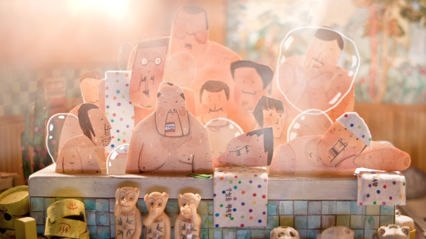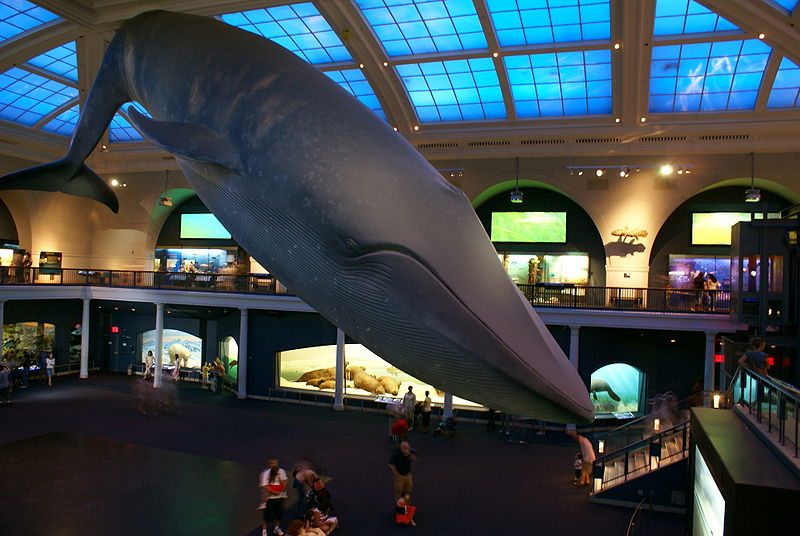
What do science museums have in common with animation? They give people insight into structure and possibility. One reason I've always loved industrial tours is that they give people a chance to witness the actual mechanics of various manufacturing processes, whether they involve brewing beer or constructing airplanes.
In January 2001, a series of documentary shorts created for television transformed the industrial tour into an armchair adventure. How It's Made showed audiences around the world the processes which led to fully-formed guitars, plastic bags and kayaks as well as bubblegum, solar panels, and helicopters. In the following segment, viewers learn how a hammock is made.
How does one get from standing in the Milstein Family Hall of Ocean Life in the American Museum of Natural History and looking up at a life-sized model of a 94-foot long blue whale to creating an animation sequence for Monstro the Whale? It takes lots of talent -- and even more patience.
The 94-foot-long model of a blue whale on display
at the American Museum of Natural History
* * * * * * * * * *
I'm always fascinated by the imagination that goes into various forms of animation. Claymation has become a favorite tool for marketing campaigns such as the one created for the California Raisins. But the stop motion work of Nick Park (the creator of the popular Wallace and Gromit series) has taken the art of working with Plasticine to incredible levels. Consider the following two clips from Creature Comforts and Shaun The Sheep:
In the following clip, Andy Symanowski, one of the key animators for Aardman Animations, explains some of the finer points of creating a new 3D full-length animated feature (The Pirates!) which is scheduled for release this spring.
* * * * * * * * * *
One of the most topical uses of stop motion has been Q. Allan Brocka's hilarious Rick & Steve: The Happiest Gay Couple in All The World.
Whereas Matt Stone and Trey Parker (the creators of South Park) have always been able to react quickly to breaking news events, their speed is helped by the fact that they are primarily working in two dimensions with paper cut-outs. A show like Rick & Steve requires miniature sets and puppets for each character, as explained in the following video.
* * * * * * * * * *
My recent curiosity about what goes on behind the scenes of a stop animation film was triggered by watching a delightful eight-minute long short by Kangmin Kim that was shown at both the Sundance and San Francisco International Asian-American Film Festivals. In 38-39° C, a man enters a public bathhouse and, as the intense heat and steam lull him to sleep, begins to dream of his relationship with his father.

Steam fills the bathhouse in Kangmin Kim's short film
Using paper cut-outs, Kim fills his protagonist's dreams with memories of dead relatives and strange men that he and his father used to see on their trips to the bathhouse.

Some of the paper cut-outs used by Kangmin Kim in his film
Some of the film was created using mechanical dolls created specifically for scenes in a miniature bathhouse.
The following teaser gives a brief glimpse into the color palette used by Kim for his film:
As the young filmmaker explains:
"I think of myself as a designer, not an artist. When I watch P.C. animation, I feel really different. Something about it doesn't feel alive. Since this was a two-year project, I had to do everything. During the day I drank tea and listened to music. At night, I went to the set and just played with my characters all night. Once I had the camera in front of the set, I let my inspiration manage the process.
This movie did not have a storyboard at all. I just drew in my sketchbook for inspiration until I had done the set. Since this was the final tyro movie in my life, I didn't wish to have any limitations. Instead, I longed for the assembly to feel the emotions from images, not plot. I admire the hardness of stop motion because it takes objects from actual life. Characters were not critical to me; the bathhouse was more important."
You can watch Kim at work and get a sense of his artistic vision in the following clip:
* * * * * * * * * *
While many traditions in the world of animation are stylistic ones that have been handed down from one generation of artists to another, sometimes animators take great fun in turning tradition upside down and inside out. Consider the following example:
To read more of George Heymont go to My Cultural Landscape

